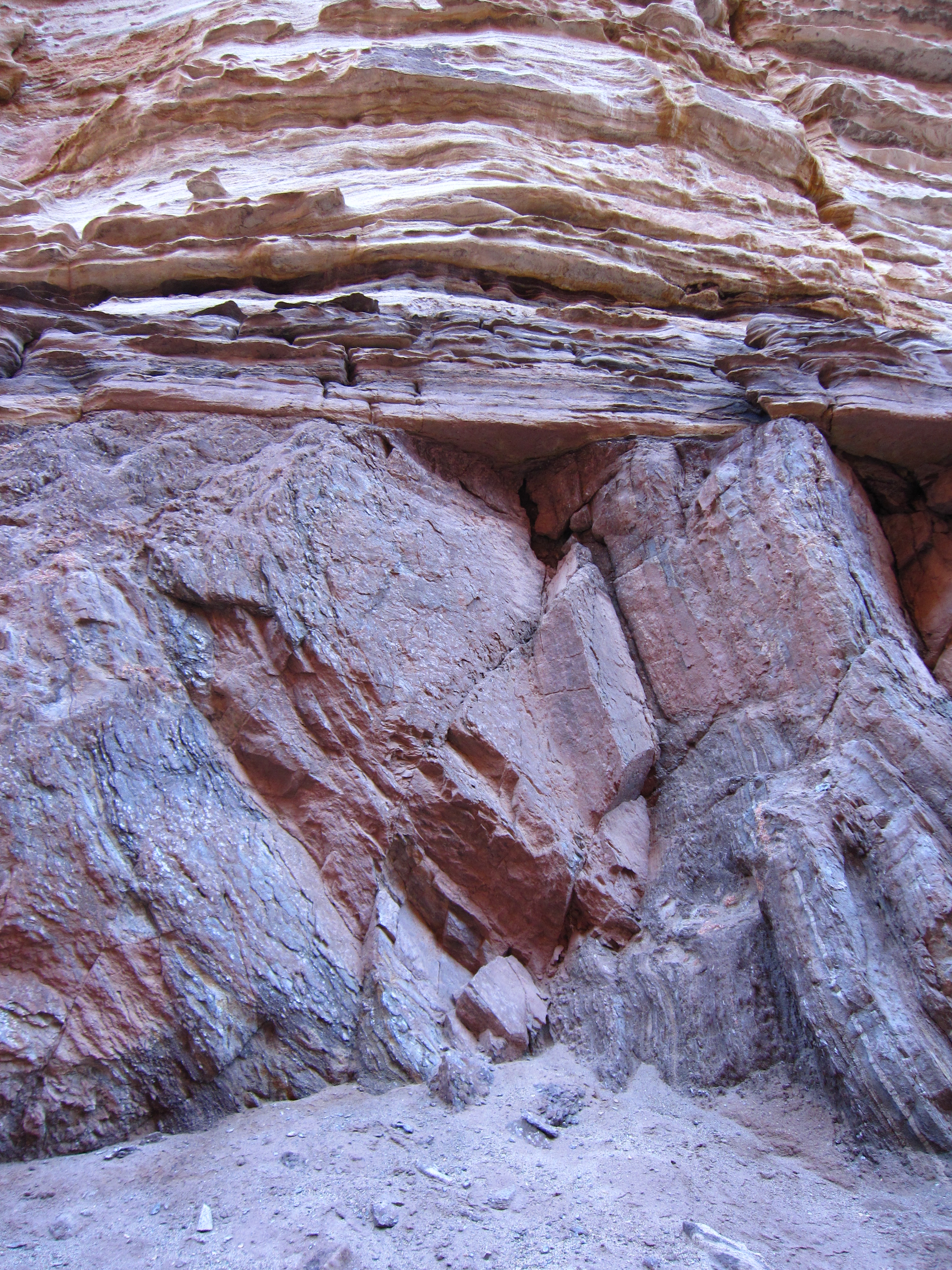
Credit: Chris M Morris (cm195902 on Flickr) https://www.flickr.com/people/79666107@N00/, CC BY 2.0, via Wikimedia Commons
When the first geologists explored the Grand Canyon, they discovered a billion-year mystery that we still haven’t solved.
John Wesley Powell, on his 1868 expedition, called the mile-high canyon walls the “The Library of the Gods” – where he saw 2 billion years of Earth’s history piled in rock layers one atop the other …
Except, he realized, there were hundreds of millions of years of rock layers missing!
Later geologists found this great "unconformity" -- a break in the geologic rock record -- everywhere. All around the world, the same billion years of rock was simply … gone. What happened?
One hypothesis holds that, long ago, when Earth was repeatedly covered in ice for many millions of years, glaciers slid and moved over continents and abraded them down by a mile or more.
Another hypothesis relates to heat. For about half a billion years, all of Earth’s land surface was concentrated in one supercontinent called Rodinia. With fewer outlets for Earth’s mantle heat, Rodinia would have expanded and uplifted by a few miles.
Erosion before, during and especially following that uplift could have stripped away a mile of rock.
More likely, it was a combination of events that washed billions of tons of eroded minerals into the ocean – to enrich and support the Cambrian Explosion of Life that happened just after.
A billion-year mystery that eventually led to ... us.
Background
Synopsis: During his 1869 Grand Canyon rafting expedition, John Wesley Powell discovered a remarkable geological feature: the Great Unconformity that separated terrifically contorted rocks below from a flat lying sandstone above. The underlying rocks are more than a billion years older than the overlying 525 million-year-old sandstone. This isn’t just a local event, it is one of Earth’s greatest mysteries. Everywhere on Earth where rocks of this age can be found, around a billion years of Earth history has been erased. What was Earth doing for that secret billion years?
- Like a diary, Earth’s history is recorded in its rocks. That’s what geologists mean when they refer to the “rock record.”
- The details of what occurred at a particular place during a given geological episode are recorded as layers of progressively younger sediments as they pile up, like pages in a diary (if you turn it upside down so the newest entries are on top).
- The most recent developments are found at the top of the pile.

Earth’s geological record records history like a stack of history books or diaries, with the youngest pages on top.
Credit: Ch. Maderthoner, CC0, via Wikimedia Commons - Igneous and metamorphic rocks provide additional clues in some tectonically active areas, like extra doodles on diary pages.
- But sometimes, sediments are not deposited, or rocks are eroded away, leaving a gap in the rock record known as an unconformity. There are a few different types:
- If sediments are not preserved in an area for a long period of time there is a hiatus, a pause in the geological rock record. A hiatus no record in the rocks, so the record left behind is a surface that is parallel to the rocks above and below which is called a disconformity. It is like a blank page in Earth’s diary. Who knows what happened during that time?
- At other times, erosional forces like rivers, floods or glaciers tear through sediments to remove them, and if this goes on for long enough it is like tearing pages out of the diary. Scientists call this an unconformity, and it erases the record of things that happened, leaving behind a secret past.
- If erosion happens in an area where a lot of tectonic activity has occurred and rocks have been faulted and folded, dipping rocks can be cut off at angles to produce an angular unconformity. Like ripping off the edges of a bunch of pages.
- Unconformities are very common between layers of sediments or volcanics, but if they occur where layered rocks cover igneous or metamorphic rocks, they are known as nonconformities, because different types of rock come in contact with one another.
- Unconformities, big and small, occur throughout the rock record.
- They are some of the most important clues that geologists use to reconstruct the secrets of geological history, usually on a regional basis.
- Sediments above an unconformity are always younger than the materials below it, unless they have been flipped over (overturned) by later tectonic processes.
- Erosion in one area results in deposition in another area at the time of the erosional event, so geologists act like detectives to find vestiges of the missing pages and to figure out what caused them to be torn out.
- One of Earth’s biggest secrets is kept within a gigantic unconformity, known as the Great Unconformity, that can be found all over the world, concealing around a billion years of Earth history. It was named by Clarence Dutton in 1882.
- Sometimes the Great Unconformity is visible at the surface, but even if it is buried, when you drill a hole into old enough rocks, you will find it.
- While other famous geologists noted other extensive unconformities, like Hutton’s Unconformity in Scotland, the Great Unconformity has all of those beat!
- The Great Unconformity represents as much as 1.3 billion years of time not represented in the geological rock record, and it can be found in many places, from the western United States to the Ozarks, Canada, Siberia, Brazil and Australia.
- The first person to document this amazing geological feature was John Wesley Powell in 1869 during his famous rafting expedition through the incredible geological exposures of the Grand Canyon.
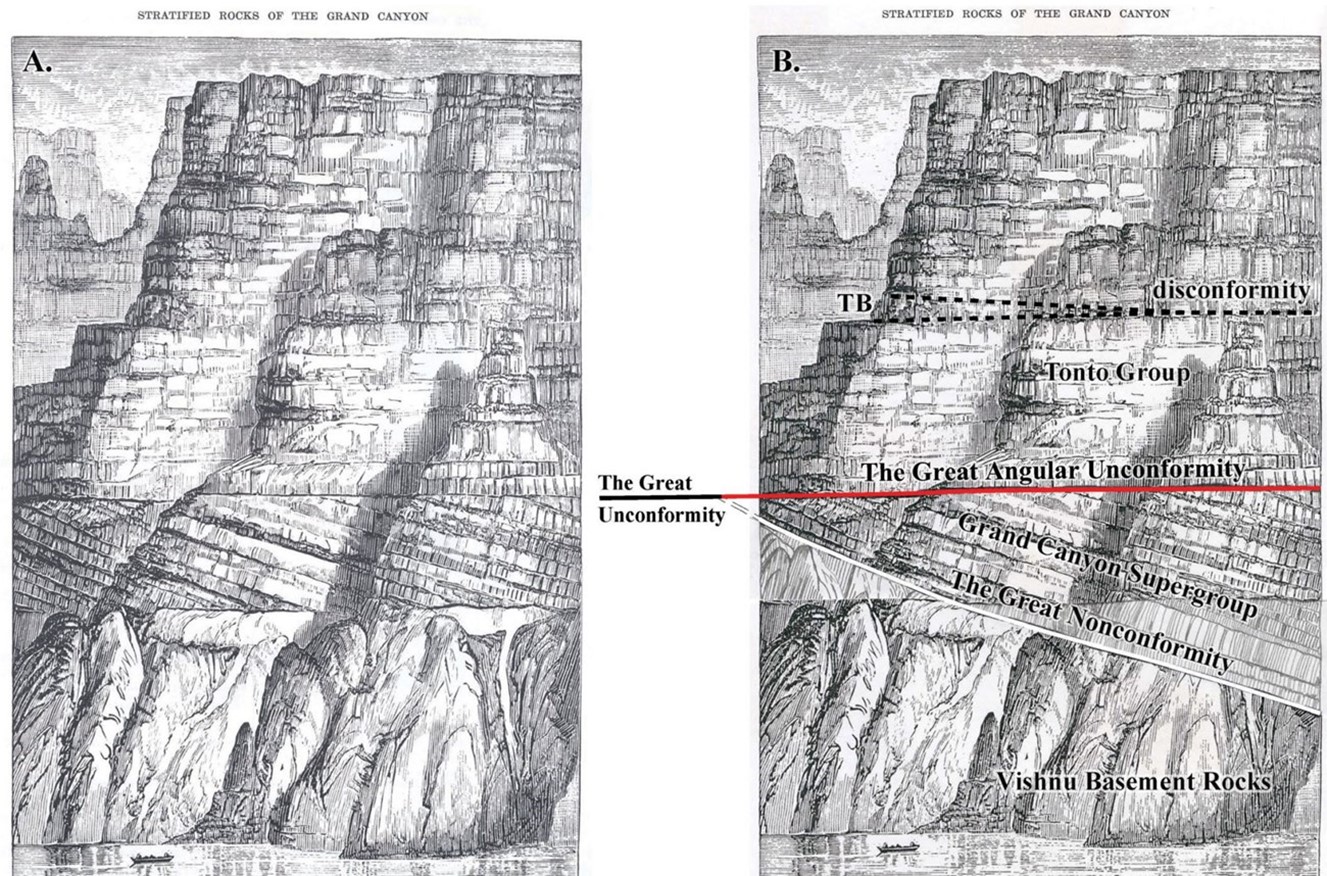
John Wesley Powell recognized the three main packages of rocks exposed in Grand Canyon; his original 1875 drawing is on the left. The image on the right shows newer names and an important correction in the lower two rock packages.
Credit: NPS- We talked about the expedition in ED-101 The Man and the Canyon and about the Canyon itself in ED-121 Carving a Canyon.
- Powell called the Grand Canyon “The Library of the Gods,” a place where the layers of rock formed the "stony leaves of one great book."
- It is astonishing and ironic that, with a vertical mile of exposed rocks, the Grand Canyon is known to include one of the most complete geological records on Earth, yet more of Earth’s history is missing from the Canyon’s rocks than is preserved.

Grand Canyon has one of the world’s most complete geologic records, covering almost 2 billion years. Yet more rock record is missing (black) than preserved in the rock column at right. Red letters are approximate numeric totals for the time not represented by rocks ” (eroded or not deposited) along each unconformity. Where the dashed and solid black unconformities join, more than a billion years of history is missing.
(Ma means millions of years while Ga means billions of years.)
Credit: International Commission on Geoheritage
- The mystery of what happened to the rocks on Earth’s surface during all that time is perplexing, especially since it occurred right before the astounding proliferation of life that took just 13 to 25 million years in the Cambrian Period.
- A billion years of rocks were erased or not deposited all over Earth’s surface during the time that the supercontinent of Nuna (1.8–1.3 Ga) broke up and the supercontinent of Rodinia assembled.(1.2–0.75 Ga).
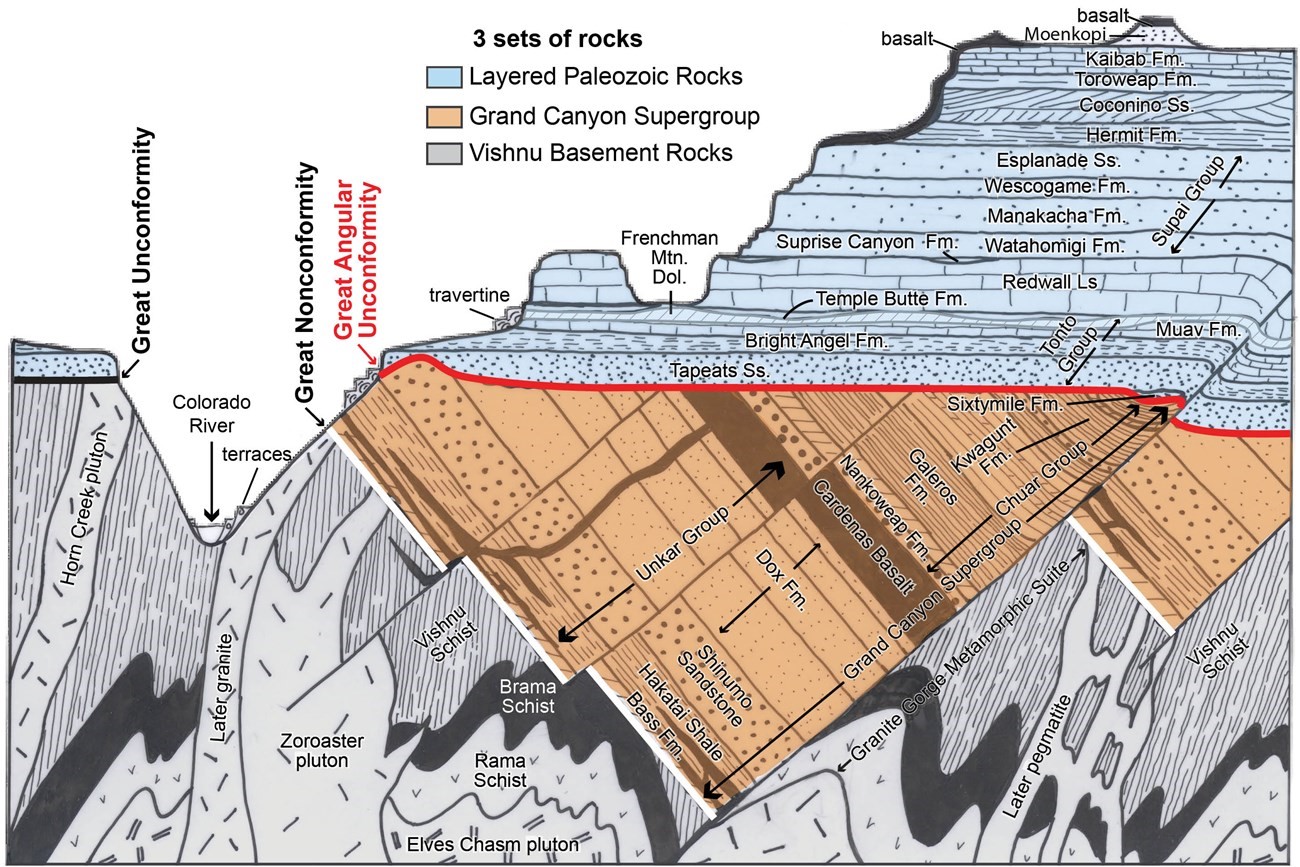
In the Grand Canyon, the Great Unconformity (bold black) occurs where the Great Angular Unconformity (red, representing about 200–300 million years of missing history) joins the Great Nonconformity (white, representing 500 million years of missing history). The Grand Canyon Supergroup represents about another 500 million years, so where it is missing, the gap in the rock record is 1.3 billion years.
Credit: NPS - While it must be giving us a very important clue about Earth history because it is so widespread, the story is not well constrained because not much evidence was left behind.
- But, of course, scientists have a few ideas.
- A billion years of rocks were erased or not deposited all over Earth’s surface during the time that the supercontinent of Nuna (1.8–1.3 Ga) broke up and the supercontinent of Rodinia assembled.(1.2–0.75 Ga).
- One hypothesis is that from 720 to 635 million years ago during Snowball Earth (ED-253 Snowball Earth) moving glaciers abraded the continents, removing at least 1 mi (1.6 km) and as much as 2 to 3 mi (3–5 km) of rock.
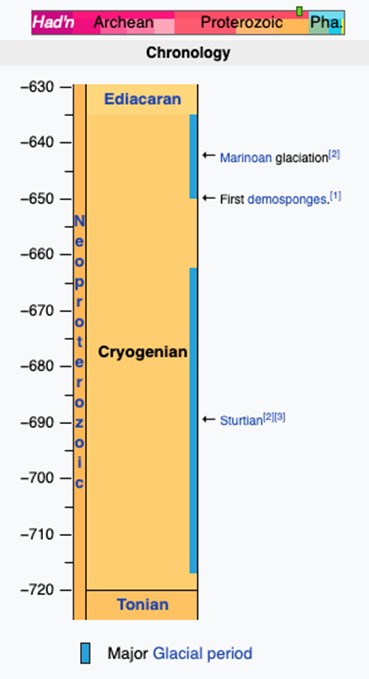
The Cryogenian Period and its two ice ages are part of the Late Proterozoic Eon.
Credit: Wikimedia Commons- But that still leaves another 100 million years of non-deposition after the glaciation and before the first Cambrian deposits, which some scientists have explained by isostatic rebound after the glaciers melted.
- The material eroded by glaciation would have ended up in deep ocean basins and would have been subducted to produce magmas with crustal compositions.
- Hafnium and oxygen isotopic ratios in zircons from this time period (late Neoproterozoic, 640–540 Ma) support the concept that plentiful crustal materials, probably sediments, were being recycled by subduction to produce volumes of magma that has been preserved.
- Another hypothesis revolves around the breakup of the supercontinent of Rodinia around 850 to 680 million years ago.
- All of Earth’s ancient continents, including parts of Antarctica, India, Siberia, China, South America, North America and Africa, were assembled together for about 450 million years.
- With fewer outlets for mantle heat, the continent would have heated up, and its rocks would have expanded, leading to 200 million years of uplift on the order of 3.7 to 5 mi (6–8 km) of the whole hilly plateau of a continent.
- Zircons from the Ozarks support the timing and rates of basement cooling that lead to the idea of continental exhumation.
- With this amount of erosion, the chemistry of the ocean and atmosphere would have changed, locking down carbon dioxide to cool the planet, causing Snowball Earth after the sediments were eroded. (The glacial model mentioned above requires the opposite: erosion after Snowball Earth froze over).
- The most recent idea is that the Great Unconformity is a combination of both, as well as additional factors yet to be determined. This echoes the wisdom of the earliest explorers that the unconformity is the result of several stages of erosion.
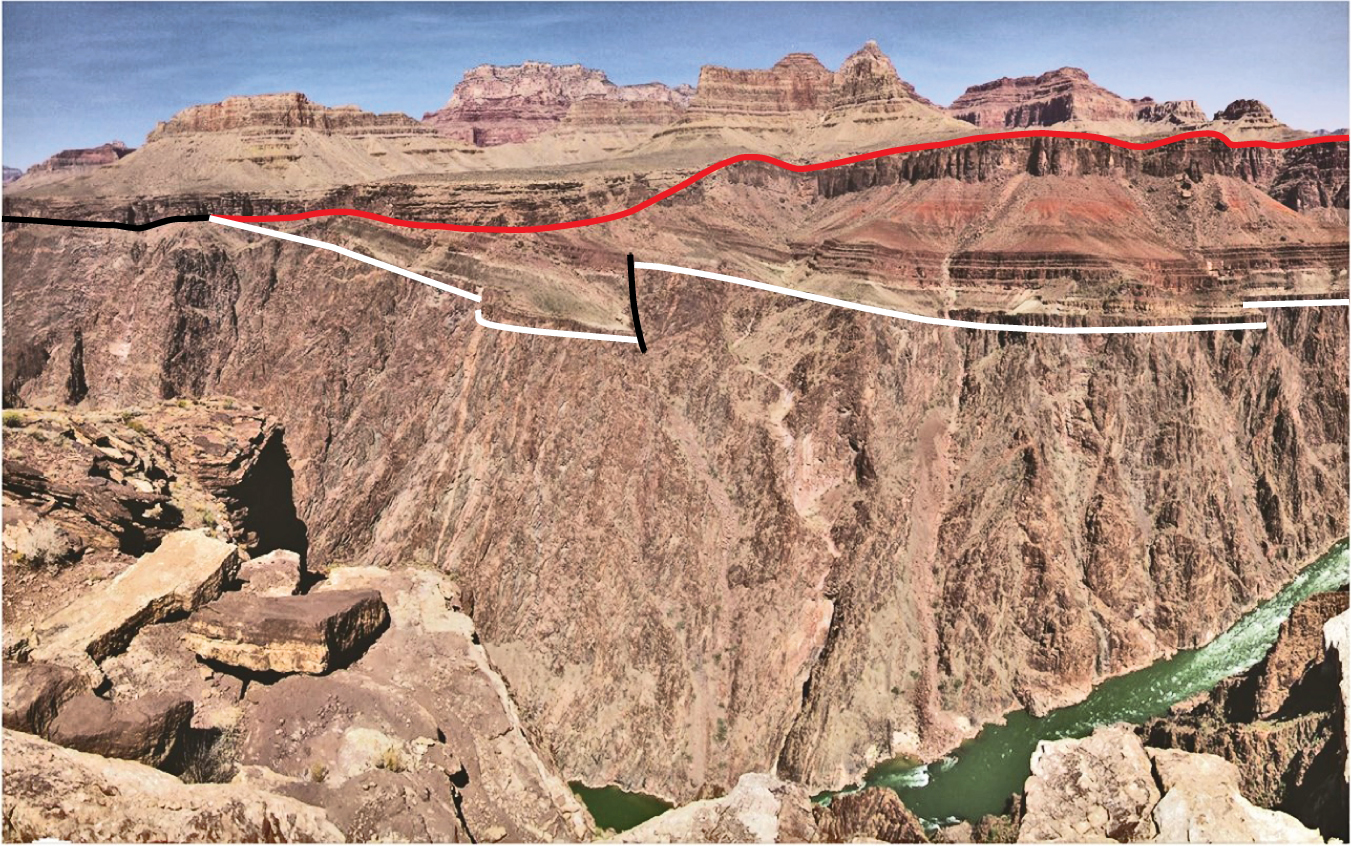
All three unconformities can be seen from several places along the rim. The Grand Canyon Supergroup is not exposed everywhere, but this view from Lipan Point, looking north from Horseshoe Mesa in eastern Grand Canyon, shows the Great Nonconformity (white line) with the 1.25 Ga basal Grand Canyon Supergroup resting on the 1.75 Ga Vishnu Basement Rocks. Up to 500 million years of Earth history is missing (not recorded) at this contact. Also shown is the Great Angular Unconformity (red line) where the 510 Ma Layered Paleozoic Rocks rest on the tilted 1,250 to 1,100 Ma Unkar Group of the Grand Canyon Supergroup, with 590 to 740 million years of history missing (not recorded) along this contact. These two profound erosion surfaces come together to form the Great Unconformity (black line) where the Layered Paleozoic Rocks overlie Vishnu Basement Rocks (black line).
Credit: NPS/Carl Bowman- Erosion in the Grand Canyon appears to have occurred before snowball glaciation, and it also appears to have occurred in distinct tectonic pulses, not as a singular event. This would lean more toward the Rodinia exhumation and breakup concept.
- The Great Unconformity in rocks on Canadian Shield near Hudson Bay appears to have been formed by erosion during or after snowball glaciation, leaning more toward the Snowball Earth idea.
- In 1969, the Grand Canyon’s preeminent former park naturalist, Eddie McKee, stated that “this unconformity is a composite erosion surface. These unconformities were discussed by Powell (1875), who pointed out that each represents a sequence of events of tremendous importance in Earth history, including the formation of mountains by tectonic forces, the erosion of these mountains to a condition of base level, and finally, the burial of the erosion surface by sediments of advancing seas.” The wisdom of the ages.
- All of these hypotheses explain mineral enrichment of the ocean that would have benefited the expansion of life to trigger the Cambrian Explosion of Life.

